What we can learn from the 4 Biggest Marketing Nightmares from Global Brands
Leading brands have great marketing. They need to because it’s how they stand out from their competitors. With massive budgets allocated to marketing, companies expect this department to be revenue drivers.
Strategies and campaigns are crucial to the success of a business. It is such a wide process that involves advertising, public relations, promotions, and sales. Without marketing, how would people ever know of your existence?
According to Deloitte’s CMO survey, marketing budgets on average take up to 11% of the total company’s budget. The biggest spenders are those in the consumer packaged goods industry. This industry forks out more than double the average budget. 24% to be exact.
Consumer behavior is extremely diverse. Every individual is unique. Brands need to diversify to reach their target audience. Most big brands make use of all the channels out there and focus on the ones with the most returns.
With huge sums of money being spent, utmost perfection is expected. However, you can’t expect to hit a home run every single time. Even with the best of the best working in your teams, there will be mistakes that may turn into disasters. We are humans after all. It happens to the best of us.
Here, we take a look at four globally recognized brands from different industries. We go over their marketing efforts as well as the marketing nightmares they have faced over recent years.
Marketing Nightmare #1
Let’s zoom in on Dove and its marketing practices. In 2017, it launched a campaign that became known as Bottlegate. But before we go deeper into the campaign, let’s take a look at Dove’s background. Owned by Unilever, Dove is a personal care brand sold in over 150 countries. Brand Finance estimated the Unilever-owned company to be worth $4.1bn (£3bn), making it the 10th most valuable beauty brand in the world. It offers products such as deodorants, body washes, lotions, hair care, and facial care.
Over the years, Dove has established a brand image through its marketing efforts. In the minds of its customers, it has established itself as a purpose-driven brand. It supports and celebrates women.
When you visit the Dove website, it refers to itself as the ‘home of real beauty’. As you scroll down, you’ll read:
“Beauty is not defined by shape, size, or color – it’s feeling like the best version of yourself. Authentic. Unique. Real.”
With its marketing team, this personal care brand took a very intelligent approach. It conducted a study to explore the thoughts and emotions of its consumers and potential consumers. And the approach was spot on!
The ‘Real Beauty’ campaign kicked off in 2004. It was the result of a study conducted on 3,200 women all around the world aged 18-64. Dove was on a mission to understand what women felt and thought about living in this era.
Very interesting numbers from the study:
31% of women viewed themselves as natural
29% of women viewed themselves as average
Only 2% saw themselves as beautiful
The numbers were obvious. Most women did not see that they were beautiful. The majority of women thought of themselves as your regular Jane Doe. Moreover, one-third leaned towards being natural. With these results, Dove moved on to the next step.
The study changed the beauty industry. Dove started using digital experiences to emotionally connect with its audience. The strategy was to help women feel comfortable with who they were. That normal people also mattered to the world. And they definitely succeeded.
For more than 15 years, Dove ran successful campaigns associated with a positive body image. One very effective campaign was their billboard ads. When other brands focused on only using professional models, Dove hired ordinary women to grace their billboards. The public loved this campaign because it showed that “normal” women could also be models.
Success after success, the “Real Beauty” campaigns continued to roll out. However, in 2017, Dove caught everyone by surprise. The launch of the limited edition bottles aimed to communicate that every body type is beautiful. But it failed to do just that. The campaign received some heavy blows on the Internet and proved to be a complete disaster.
Check out the advertisement here:
The campaign
Dove manufactured six different types of bottles. What was the difference? The shower gel inside was the same, but each bottle resembled a woman’s body type. The campaign was the brainchild of globally recognized Ogilvy London and this is the message they were trying to convey:
“Beauty comes in a million different shapes and sizes. Our six exclusive bottle designs celebrate this diversity: just like women, we wanted to show that our iconic bottle can come in all shapes and sizes, too.” -Dove website
There are different body shapes and the bottles represented that. From voluptuous to slim, tall to petite. The image below shows six of the limited edition bottles and the original bottle (far left). There’s an hourglass bottle. A tall, thin bottle with smaller curves. A pear-shaped bottle. An even squatter pear-shaped bottle.
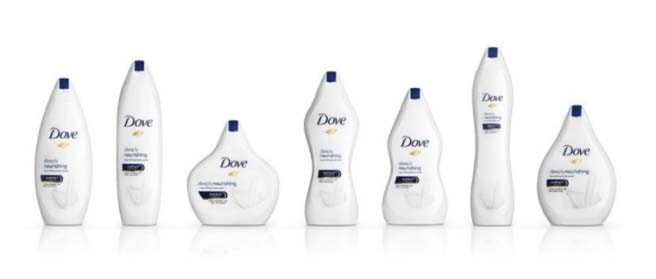
The concept here was whether you were tall and skinny, petite and round, curvaceous, it didn’t matter. The bottles were supposed to remind everyone to celebrate this diversity.
What went wrong?
The idea sounded great! It was all about respecting everyone’s beauty, different body shapes, and sizes. But the public thought about it and decided to give it a big thumbs down. Instead, it backfired and things turned bitter for Dove.
How did a brand that always got it right all of a sudden get it wrong? Their entire mission and vision had been completely misunderstood. Weren’t they trying to communicate the importance of real beauty? Why were they now reminding their consumers about their body shape?
The women that bought Dove felt confused about the bottles. Which ones were they supposed to buy? The ones that resembled their body shape?
They started comparing themselves to other women as well. They even wondered if they could buy a bottle that didn’t represent their physical appearance.
Reaction?
Dove had good intentions, but the message just didn’t seem to hit the target. These days people will take it to social media and share it with the world. Social media can be very influential on society as well as damaging for a brand’s image. In this case, posts mocking the Dove limited edition bottles were shared and seen by thousands.
Here are some reactions on Twitter:



A swarm of Twitter users made fun of the brand. Some of the posts received thousands of likes and were re-tweeted many times. Most users expressed that Dove was supposed to be inspiring body positivity, not self-consciousness. The ‘Real Beauty’ campaign became a laughing stock all over social media. Memes popped up here and there.
The verdict was in. The public viewed the campaign as ridiculous. It wasn’t only social media. Critics also had something to say about the campaign.
“Dove’s attempt to create a product experience that ‘liberates’ the user from self-doubt accidentally stirs up that very thing.” – The Atlantic
Many journalists also referred to the whole ordeal as Bottlegate. They noted that the beauty giant had gone from empowering to patronizing its consumers. It had crossed the line with these bottles.
According to an article by The Guardian, real beauty clearly was not a bottle of shower gel. If a woman wanted to feel at peace with herself, real beauty would be her own type of body without being compared to a product. The fact that Dove compared beauty to bottles was why everyone just didn’t get it.
What did Dove do next? To deal with this crisis, Sophie Galvani, the Global Brand Vice-President, addressed the public. She explained that Dove celebrates all women. The limited-edition bottles were designed to celebrate the diversity of all women and that they were not available for sale.
In an official statement, she focused more heavily on their positive impact, rather than this slip up:
“We take women’s beauty confidence very seriously. Through the Dove-self-esteem project, we have reached more than 20 million young people with body-confidence education, and we aim to reach 20 million more by 2020.”
Key Takeaways
For over a decade, Dove had stood out from its competitors. It had the kind of brand personality everyone wanted to be acquainted with. The company had invested a lot of money into research, creativity, and brand promise. And it proved to be worth it.
Millions of women felt connected to the ‘Real Beauty’ campaigns. They could relate and this generated a ton of sales for Unilever. So where did it all go wrong?
Was it a message with good intentions gone wrong? Perhaps.
Was the communication from A to B somewhat distorted? Possibly.
According to Andrew Walen, the founder, and CEO of the Body Image Therapy Center in the nation’s capital, it simply missed the mark. If you present objects instead of using real people, you’re giving the public something to tease you about.
“The more we dehumanize the experience of having different body types, the easier it is to say there’s something wrong with you,” he said.
As it became the laughingstock of the Internet, Dove and its reps gave very few comments and let the whole thing pass by. The bottles were not for sale, but until today, you can still read about the limited edition bottles under the archived campaign section on the Dove website.
After spending some weeks as the subject of ridicule, everyone moved on. Although it was a marketing nightmare, many still loved the brand. According to a survey by Morning Consult, the product continued to be rated above competitors such as Olay and Nivea.
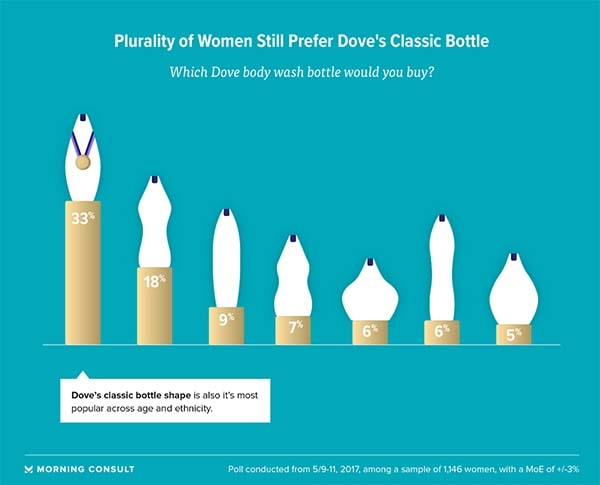
Out of curiosity, the market research company conducted a poll to see which bottle women would buy if they were put on shelves. Most women still preferred the original bottle, followed by the one that looked like a voluptuous woman.
Which bottle would you choose?
Marketing Nightmare #2
I’m sure you’ve heard of Kendall Jenner. With over 130 million followers on Instagram, she is a well-known model and media personality. Born in 1995, she rose to fame in the reality tv show ‘Keeping Up with the Kardashians’, which also featured her famous family.
I’m sure you’ve also consumed Pepsi before. Originally created way back in the 1890s, Pepsi is a carbonated drink. That’s over a century of sales and marketing experience. Widely considered to be a longtime rival of Coca-Cola, this is what their market share in the US looks like.
Pepsi Co: 30.8%
Coca-Cola: 42.7%
Coca-Cola leads the way in the US, with Pepsi not far behind. But in other parts of the world, Pepsi outsells its rival such as in Oman, India, Dominican Republic, and Guatemala. As you can see, these two are the leading brands in the carbonated drinks industry.
For these huge brands, celebrity advertisements are not unheard of. Over the years, Pepsi has shot commercials starring Britney Spears, Pink, Beyoncé, and Enrique Iglesias. All of them are household names.
Leveraging on Jenner’s star power, Pepsi decided to team up with her in its 2017 commercial. This is a classic example of celebrity branding, which is the use of a famous person to generate buzz around a brand. Having a celebrity as the subject of your advertisement can be a powerful marketing tool. And Pepsi did just that.
For 3 years from 2001-2004, Spears’ collaboration with Pepsi was perfection. On the other hand, Jenner’s experience was short-lived proving to be quite different. In April 2017, Pepsi aired a 2-minute commercial, which led to controversy. It was a major misstep and execs at Pepsi ended up pulling the ad.
The Commercial
“Live for Now” also known as “Live for Now Moments Anthem” was the title of the commercial that was pulled one day after it debuted. It received so much criticism on social media and media outlets. To make matters worse, many also used it to entertain their audiences.
According to Wikipedia’s description, the ad kicks off with a hand opening a can of Pepsi and then shows a young man playing the cello on a rooftop. The music soundtrack begins and the view switches to a protest with people showing gestures of peace and carrying signs that read “Join the Conversation” and peace symbols.
The view then switches to a young woman, who appears to be a professional photographer going through her print photographs. Then the view switches to Jenner’s character, who is in the middle of a photoshoot. As she models, she becomes aware of the protesters outside. The cellist also notices the protest and then takes a sip of Pepsi while watching the protesters from a balcony.
The view then switches to the photographer. She also notices the protest outside. She grabs her camera and heads towards the protesters. The cellist then gestures to Jenner to join them and she responds by removing her blond wig. She hands the wig to her assistant and walks toward the marchers.
The camera then focuses on police officers who are monitoring the protest. Jenner walks up to the officers and hands a can of Pepsi to one of them. As she does this, the photographer snaps a few shots of this interaction. The police officer drinks from the can and you can hear the crowd cheering. The photographer puts aside her camera and hugs a protester. The commercial ends displaying the phrases “Live Bolder”, “Live Louder”, and “Live for Now”.
See the full ad here:
The problem was that the ad resembled the protests in the Black Lives Matter movement. The shot of Jenner walking up to the officers was almost identical to Taking a Stand in Baton Rouge. Comparisons were made to the July 2016 event when a woman named Iesha Evans approached police on her own and was subsequently arrested. The memories of these events were still fresh and real.
Many condemned Pepsi for not being sensitive to this issue. And whenever well-known companies make a mistake in the eyes of the public, they get punished for it.
Here’s what Twitter users had to say:
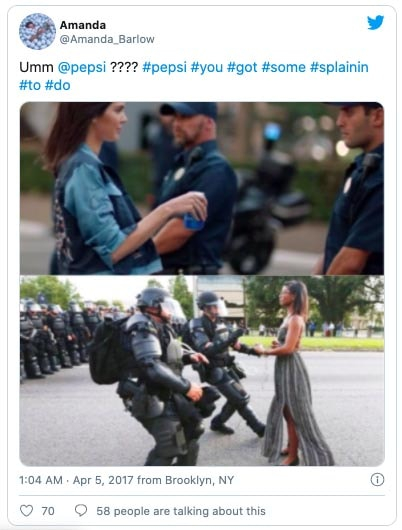
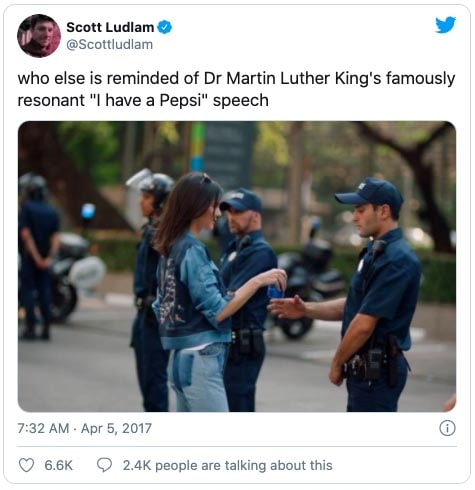
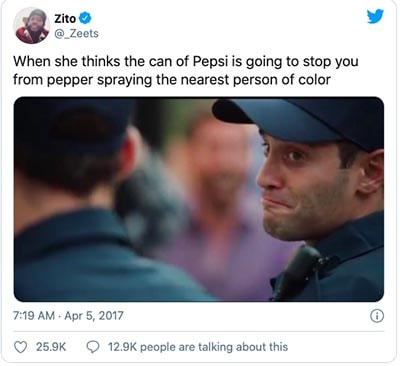
Not only was it the center of attention on Twitter, but the advertisement was also the subject of a YouTube parody video. Comedian Vito Gesualdi took advantage of the opportunity by attending an anti-Trump protest in Berkeley, California. He recorded himself walking through a group of violent protesters where he tried offering them a can of Pepsi. In the commercial, as Jenner hands the can to an officer, the crowd of protesters respond with cheers and everything calms down. But in real life, as Gesualdi was trying to do this, it didn’t work. The protesters ignored him and remained hostile.
His video went viral. Titled ‘Berkeley Protesters Take the Pepsi Challenge’, the video has close to 4 million views to date. You can watch it below here:
Pepsi had been ridiculed on Twitter and YouTube. But things didn’t stop there. What was even worse was Saturday Night Live also referred to the commercial in one of their sketches. In the sketch, Beck Bennet plays the guy behind the vision of the protest ad. As he’s on the phone, he tries to explain this brilliant storyline he came up with. He’s heard saying:
“Okay, so, well it’s an homage to the resistance. There’s this huge protest in the street, reminiscent of Black Lives Matter. So everybody’s marching, right, and they get to these police officers and you think it’s going to go bad because there’s a standoff, and then Kendall Jenner walks in and walks up to one of the police officers and she hands him a Pepsi. And that Pepsi brings everyone together. Isn’t that like the best ad ever?”
Then Jenner’s character, played by Cecily Strong, enters the scene. She’s also on the phone with one of her famous sisters going over her latest gig.
“I stop police from shooting black people by giving them a Pepsi,” she says. “I know, it’s cute, right?”
Public Apology
When a company as big as Pepsi makes a mistake of this magnitude, it is forced to act quickly. A spokesman for the soft drinks company originally said: “This is a global ad that reflects people from different walks of life coming together in a spirit of harmony, and we think that’s an important message to convey.”
But trying to justify its actions didn’t work. One day after the whole ordeal, the commercial was taken down and Pepsi released a public apology through a press statement.
“Pepsi was trying to project a global message of unity, peace, and understanding. Clearly, we missed the mark, and we apologize. We did not intend to make light of any serious issue. We are removing the content and halting any further rollout. We also apologize for putting Kendall Jenner in this position.”
Then in October 2017, a few months after the commercial aired, Kendall Jenner finally addressed the issue. No one knows why she remained silent or what took her this long to finally speak up. In the Season 14 premiere of Keeping up with the Kardashians, she broke out in tears and showed remorse for her participation in the campaign.
In the confessional interview, she’s seen talking about how excited she was when she got the gig.
“When I first got this offer… I mean, it’s a huge company. The people I was following were so iconic and amazing,” Kendall said. “Michael Jackson has done it, Britney Spears has done it, Beyoncé has done it, Pink. The list goes on. So to get something like that was just… It was so exciting.”
She continues the interview trying to explain that she made these work decisions together with her team and that she trusted everyone.
“After I saw the reaction and I read what people had to say about it, I most definitely saw what went wrong. I was so stuck, and I really didn’t know what to do, and I completely shut down.”
Key Takeaways
With real protests dominating headlines, the Pepsi ad was tasteless. After facing so much criticism, the cola brand had to halt its commercial and apologize to the public. Here’s what we can learn from Pepsi’s epic fail.
- Be selective with trending topics
Trending topics help to garner attention. However, do not choose sensitive ones. Stay away from shooting an ad related to diseases or in this case, protests. - Make an impact by investing in corporate social responsibility projects
If your company wants to genuinely make an impact and generate publicity, don’t do it through a commercial. Instead, opt for CSR activities such as starting a good cause or making a donation. Through CSR, you can convey your intentions and positive messages. - Take responsibility for your mistakes
To be fair on Pepsi, they did act quickly after facing a lot of criticism. Pepsi made an official apology to the public and to Kendall Jenner through a press statement and several social media accounts. They realized their mistake and made the effort to soften the blow, although damage was already done. - Don’t play with politics
If you’re in charge of company branding, do not ever play with politics. Controversy does sell, but in this case, it will just lead to a negative perception of your company and a lot of hassle trying to fix it.
Marketing Nightmare #3
The vast world of marketing can be broken down into many segments. Email marketing is one of them. Alongside tech growth, we’ve also seen a boom in this form of marketing. It’s all about sending a message to a group of people via email. Many companies employ email marketing strategies with the following objectives:
To build loyalty, trust, or brand awareness
With so many advantages, it is clear why this form of marketing is so popular and widely used. It is significantly cheaper and faster than snail mail. In a matter of seconds, you send a high volume of messages. From these messages, you can also gain insights into consumer behavior. It’s one of the most measurable marketing strategies ever. You can track things such as who opened your emails and which links they clicked on. Not to mention, most people check their inboxes on a daily basis.
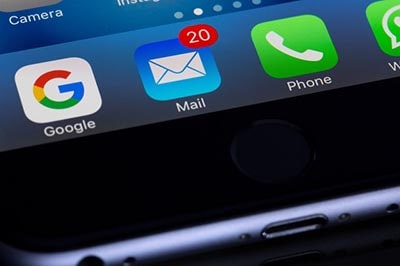
It is without a doubt that a company as big as Adidas has been using email marketing for ages. Infamous for its three stripes logo, this sportswear brand originated in Germany. The company was founded in Herzogenaurach by Adolf Dassler in 1924. Together with his elder brother Rudolf, they operated under the name Dassler Brothers Shoe Factory.
Focusing on enhancing the quality of spiked footwear for athletes, he started using canvas and rubber instead of heavy metal spikes. In 1936, Dassler managed to persuade U.S. sprinter Jesse Owens to use his spikes at the Summer Olympics. This proved to be a successful collaboration for both. Owens bagged four gold medals and the Dassler shoes became known to the whole world.
In 1947, relations between the brothers turned sour and they split up. Rudolf went on to start his own company RuDa derived from his name and Adolf started Adidas, also an abbreviation of his name. After decades of experience in the sportswear industry and a few changes in ownership, today Adidas is the largest sportswear manufacturer in Europe.
Keeping up with the times, the sportswear giant decided to stop advertising on television and shift its focus to digital media. Here is an example of their welcome email.

As you visit their online store and sign up for their newsletter, you receive this email. Based on email analytics, the average open rates for welcome emails are often above 80%. So it might be one of the most important emails your company will ever send out.
The objective of a welcome email is to remind people of your brand and your online existence. You want people to be exploring and clicking on your website. With this email, Adidas doesn’t forget to thank you. At the same time, it offers you a discount code as well as links to their top sellers. Here is a classic example of making your new subscribers happy and trying to convert them into paying customers.
Email marketing is a department where Adidas has really excelled in the past few years. However, we all make mistakes. It’s what makes us humans. In 2017, Adidas blasted out an email to all Boston Marathon finishers. The subject line read:
“Congrats, you survived the Boston Marathon!”
Clearly, Adidas had good intentions. They wanted to congratulate everyone for achieving such a feat! But what they didn’t take into account was the events from four years before and how the public would perceive it. During the 2013 Boston Marathon, there was a bombing, which killed three people and injured more than 260. 17 people lost their limbs.
Motivated by extremist Islamic beliefs, two brothers planted two homemade bombs near the finish line of the race. Both bombs went off within 14 seconds of each other. Not associated with any terrorist groups, no one knew why they would commit such a horrific act. One of the brothers later admitted that they also had plans to detonate a bomb in Times Square, New York.
There was so much chaos and tragedy. A sporting event that was supposed to be about health and competition was now the subject of a bombing attack. Concerns over security began to mount.
Then, four years down the road, just imagine receiving an email with this subject line. Just imagine you’ve completed the prestigious Boston Marathon, a very historic race that many runners across the world would love to participate in. For some, it’s a lifetime achievement.
You open your email and get congratulated for surviving. Of course, all these memories of the bombing come rushing back. It’s no surprise that the email was met with negative reactions. How did the company fail to make this connection? Who came up with the wording?
Adidas’ blunder became the talk of the town. It spread like fire all over social media and popular news outlets.
Here are some Twitter reactions:
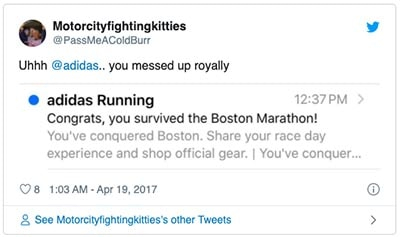
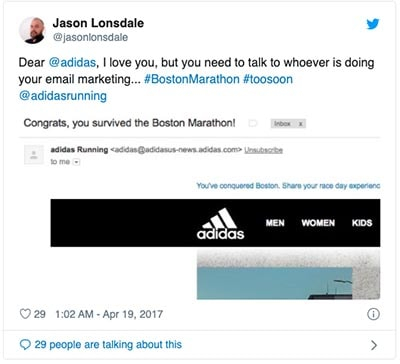

We’ve all sent out messages that we later on regret. But we can just apologize and move on. For a brand as big as Adidas, such an insensitive subject line would only lead to catastrophe. You would think that their marketers would have the expertise and experience to select better word choices.
What Adidas did next was the best and only thing they could do. Following this mistake, Adidas did the right thing. They admitted their mistake and took responsibility. Just three to four hours after the email was sent out, a public apology was issued on their social media accounts. Adidas apologized for its careless mistake and only had good words for the Boston Marathon.
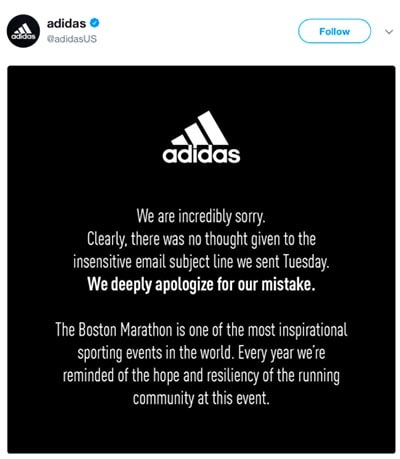
The sportswear giant was swift to respond, preventing matters from escalating. But the damage was done, and it will go down as one of the worst subject lines in email marketing history.
Fast forward a year after the email mess-up and Adidas bounced back even stronger. As the official apparel partner and to celebrate 30 years of partnership with the Boston Marathon, they came up with a brilliant idea.
Adidas, in partnership with digital agency Grow came up with the “Here to Create Legend” campaign. Drew Ungvarsky, the CEO of Grow, announced:
“We are thrilled to create a first-of-its-kind experience for Adidas at the Boston Marathon. We wanted to harness the power of 30,000 runners generating data from the very race bibs that sport the Adidas logo and transform the entire race into a creation engine. The result is an epic personal highlight film for every single runner who becomes part of the legend of this incredible event.”
Cameras had been installed in certain spots of the racecourse to capture individual videos. After the event, runners didn’t receive an insensitive email. Instead, they were in for a treat. Delivered within hours after the race ended, all runners received an email where Adidas shared access to all the videos. 30,000 runners, 30,000 unique videos.
Check out the promo video below:
Key Takeaways
Crisis Management is an important skill that companies should have. At any given time, a small issue could snowball into a big one causing long-lasting damage. It could be anything because you never know how the public will react.
With that in mind, organizations need to have a strategy to handle the crisis. And they need to do it as quickly as possible.
Here are 3 tips to handle a crisis:
- Act Quick
During a crisis, it is crucial to respond as soon as you can. The Boston Marathon email was sent out on Tuesday morning and by Tuesday afternoon, Adidas had already issued an apology. It took them only a few hours to do so. The longer you wait, there might be more damage done. Issue a statement showing that you acknowledge the crisis. But also be sure to check that all your information is accurate. - Take Responsibility
Mistakes happen and the best way to deal with them is by owning up to it. That’s exactly what Adidas did. In a matter of hours, the sportswear brand issued a sincere apology and praised the Boston Marathon. Although it was probably only one individual or department responsible for the wording, as an organization, it didn’t try to deny it or shift the blame on others. - Be Human
During a crisis, we need to keep in mind that people have emotions. That is why the crisis happened in the first place. So when we’re dealing with a crisis, try to express empathy and concern. In this case, Adidas used very strong words such as “incredibly sorry” and “deeply apologize”. Another focus of the apology was on the runners – “Every year we’re reminded of the hope and resiliency of the running community”.
Marketing Nightmare #4
The E-commerce industry is booming and there are no signs of it slowing down. During the pre-COVID era, shoppers had already been attracted to the advantages of online shopping. It’s more convenient to shop for certain items online. Items get delivered to your doorstep, you waste less time commuting, and so on.
Given the recent circumstances, more and more consumers took their shopping online. And many have said that they’re never going back. In March 2020, Statista.com recorded that global retail website traffic hit 14.3 billion visits, up 1.53 billion from two months earlier. With the masses staying at home to curb the spread, consumers turned to the Internet to make their purchases. If this is now the most popular channel for shopping, brands will have to closely monitor their campaigns and content.
What exactly is E-commerce?
According to Wikipedia, E-commerce is the activity of electronically buying or selling products on online services or over the Internet. Electronic commerce draws on technologies such as mobile commerce, electronic funds transfer, supply chain management, Internet marketing, online transaction processing, electronic data interchange (EDI), inventory management systems, and automated data collection systems.
Over the years, brands have migrated from brick and mortar to online shops. Not only are their products offered in physical retail stores, but they are also readily available on websites. With so many advantages, there’s no doubt that more and more retailers are headed in this direction.
Let’s take a look at fast-fashion clothing giant H&M. The second-largest global clothing retailer, just behind Inditex, H&M operates in 74 countries with over 5,000 stores. 10 years ago, Swedish retailer H&M virtually opened its doors. After seeing the success of online stores such as ASOS, H&M followed suit.
The retailer was slow to see the opportunity in e-commerce. In the early days, the design of the website was not very appealing. There were many flaws and the whole shopping experience wasn’t user-friendly. However, fast forward to today and the clothing giant has an online presence available in 33 countries and plans to open more online stores.
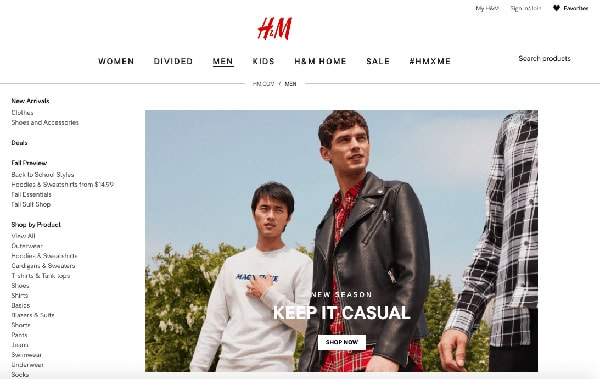
Online store website
With online shopping growing rapidly in popularity, marketers have to shift their focus to all things digital. This covers social media management, marketing campaigns, as well as content creation. If your website is now your storefront, you need to create great content as well as check everything that gets published.
For a brand like H&M who has been killing it the past decade, no one expected a slip-up. You never do from such amazing brands. That’s why when it happens, it becomes such a big deal. To many, the retailer committed one of the most infamous marketing disasters in fashion history.
What online stores like to do is have models wearing the articles of clothing for sale. It gives the customer a better sense of imagination. So, H&M UK was promoting a green hoodie for kids. It was a nice and simple hoodie with a boy of African heritage as the model. Everything looked fine as usual.
However, as you paid more attention to the text on the hoodie, you’d soon realize that it read:
COOLEST MONKEY IN
THE JUNGLE
This text was in plain white block letters. The text itself didn’t refer to anything. But when paired together with a 5-year-old boy of Kenyan descent, the Swedish retailers made an enormous mistake. The picture sparked outrage and many accused H&M for being racist.
Throughout history, racists used the word “monkey” or “ape” to refer to African people. This racist comparison is still very apparent in today’s society. It’s something that should be eradicated, but yet, we still see it in modern politics, fashion as well as sport.
In November 2016, a woman named Pamela Ramsey wrote a Facebook post that compared Michelle Obama to an “ape in heels”. In sport, it is common to hear and see monkey noises and gestures when there are African athletes on the field. It happens so often in the UK, Europe as well as the US. During Euro 2012, a banana was thrown at Mario Balotelli by Croatian fans.
It’s the 21st Century and it is unacceptable to make racist remarks or to even have the notion. The whole ordeal raised some questions as to how H&M gave the green light to this photoshoot. Who approved the text on the sweater? Were there not any internal monitoring guidelines?
Everyone had something to say about it. From athletes to celebrities, all the way to the general public. Lebron James, one of the most famous NBA players, took it to Instagram. He covered the text on the hoodie with a crown and placed a crown on the head of the African model.
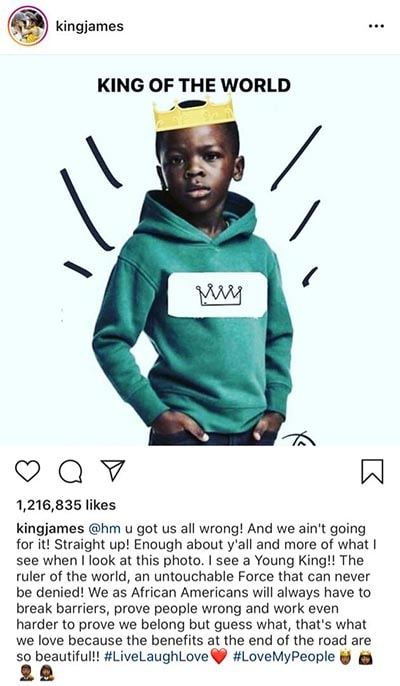
The Weeknd, singer of hit single Starboy, stated that he would never work with H&M ever again. Having partnered with them for its 2017 Spring Icons campaign and 2017 Fall collection, the singer shared his thoughts on Twitter.
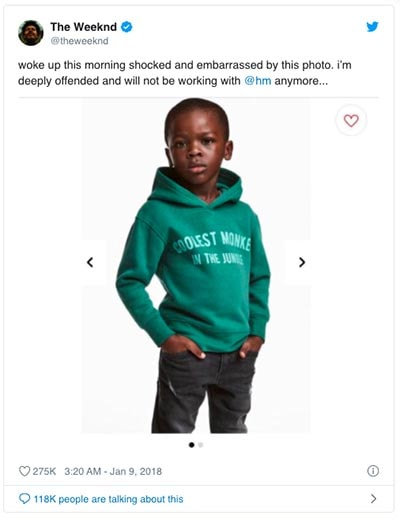
Twitter users expressed their opinions as well. Here are some reactions:
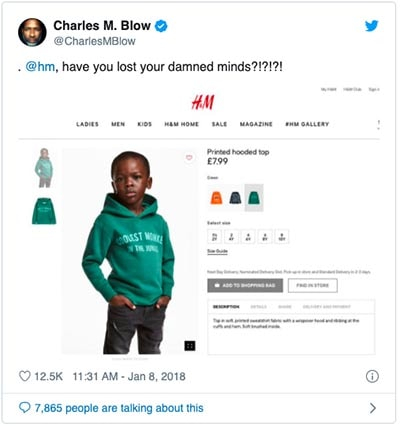
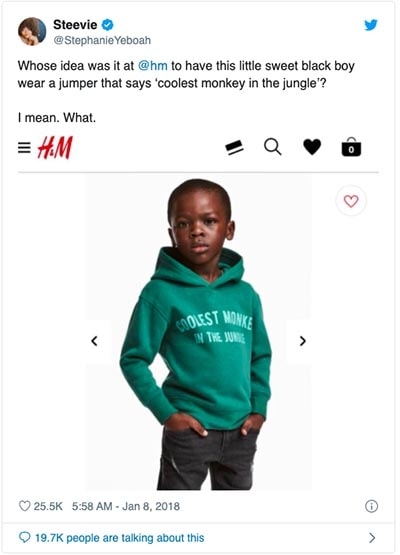
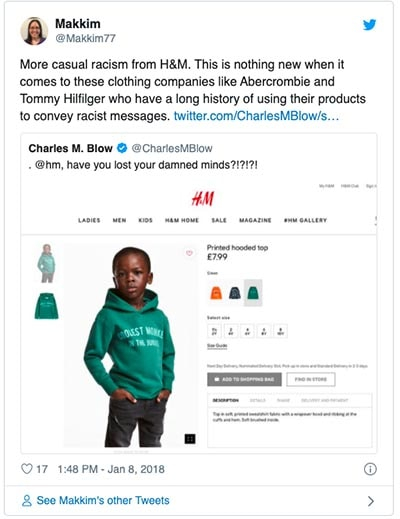
In addition to the criticism H&M faced on social media, there was physical violence in South Africa. Protesters trashed H&M outlets in Johannesburg, Capetown, and Pretoria. Due to the monkey advert, hundreds of angered activists gathered and started smashing store property. The Swedish giant was forced to close its stores after video footage showed protesters violently knocking down mannequins and ripping clothes off the rails.
How did H&M deal with the crisis?
No apology could turn the tide for H&M. However so, a sincere apology is always much needed. The Swedish retailer made two rounds of apologies. In response to the shocking and embarrassing content, H&M issued a swift apology:
“We sincerely apologize for offending people with this image of a printed hooded top. The image has been removed from all online channels and the product will not be for sale in the United States.”
Many people were not happy with the apology. The product was removed from the US store, but it was still for sale in the UK. The choice of words also didn’t express sincerity. H&M was not fully taking the blame. Instead of apologizing for promoting such an offensive product, they were apologizing for ‘offending people with this image’. You should be making an apology for your actions, not about how people feel.
The UK online store proceeded with removing the item and then came the second round of apologies. It was a long one and H&M released it to its media list.
The Full Apology
To all customers, staff, media, stakeholders, partners, suppliers, friends, and critics.
We would like to put on record our position in relation to the image and promotion of a children’s sweater, and the ensuing response and criticism.
Our position is simple and unequivocal—we have got this wrong and we are deeply sorry.
H&M is fully committed to playing its part in addressing society’s issues and problems, whether it’s diversity, working conditions or environmental protection—and many others. Our standards are high and we feel that we have made real progress over the years in playing our part in promoting diversity and inclusion. But we clearly haven’t come far enough.
We agree with all the criticism that this has generated—we have got this wrong and we agree that, even if unintentional, passive or casual racism needs to be eradicated wherever it exists. We appreciate the support of those who have seen that our product and promotion were not intended to cause offence but, as a global brand, we have a responsibility to be aware of and attuned to all racial and cultural sensitivities—and we have not lived up to this responsibility this time.
This incident is accidental in nature, but this doesn’t mean we don’t take it extremely seriously or understand the upset and discomfort it has caused.
We have taken down the image and we have removed the garment in question from sale. It will be recycled.
We will now be doing everything we possibly can to prevent this from happening again in the future.
Racism and bias in any shape or form, conscious or unconscious, deliberate or accidental, are simply unacceptable and need to be eradicated from society. In this instance, we have not been sensitive enough to this agenda.
Please accept our humble apologies.
On top of the two apologies, the Swedish brand has also put more effort into diversity, equity, and inclusion. A few months after the whole ordeal, the company hired Ezinne Kwubiri as the North America Head of Inclusion and Diversity. She launched a program called Layers. Ezinne explains:
“Layers is an interactive learning workshop where the teams come together, and we talk about a bunch of different biases and identifying gaps amongst their teams or even them as an individual that may be hindering a business decision. The concept of it is…peeling the layers. For people to have more of a reflective experience as to what their contribution may be to fostering diversity and inclusion.”
Key Takeaways
- Get it right the first time
It doesn’t look good for your company if you have to apologize two times. The first time should hit the spot. Show that you’re sincere and that you understand what you did was wrong. Never blame others. - Test any campaign on a variety of audiences
Before launching a new campaign, test it out on different groups of people. What sounds good to you and your team might not have the same reaction from your audience. Everyone is unique and we all think differently. - Include a diverse group on your creative team
A few months after the outrage, H&M offered a program to its employees focused on diversity. Education is important and so is having a diverse team. With various backgrounds and experiences, your creative team can produce work that can be globally accepted. Putting different cultures together in one room will have your team standing united. - Listen and learn from other controversies
Observe and monitor what other brands are doing wrong. Stay away from politics and controversial topics. You don’t want to get caught in this mess.
With the global population growing every year alongside advances in technology, marketing has also expanded. The creative minds of marketers come up with new ways to introduce and promote products and/or services. Campaigns and strategies are tailored according to different target groups. This is why so many channels have surfaced over the past few years.
These days, marketers like to use an array of methods. Although there are many new techniques, there are still some conventional methods that have prevailed. Marketers can opt to focus on the product itself or on promoting through TV commercials. They can also choose to communicate through email or sell items through online stores. There are so many options in a marketer’s playbook.
Based on these four marketing nightmares, whichever channel or platform is being used, marketers must always be careful. When you are promoting or selling your product to a huge audience, there’s no room for error. Such mistakes would only prove to be costly for your company. Time-consuming as well.
Double-check or even triple-check your latest campaigns. Run it by several focus groups to see if they will be accepted. And try to avoid being associated with controversial topics.
Community

Congratulations on reaching the end!
Check out other posts on entrepreneurship, or listen to high-profile experts on our podcast!
Join our Facebook Group Community with over 4,700 entrepreneurs, innovators, and creators by Startup Funding Event, where you get access to free live training, daily Q&As, design templates to get your business started, and support from the SFE team. Join here!




Leave a Reply
Want to join the discussion?Feel free to contribute!